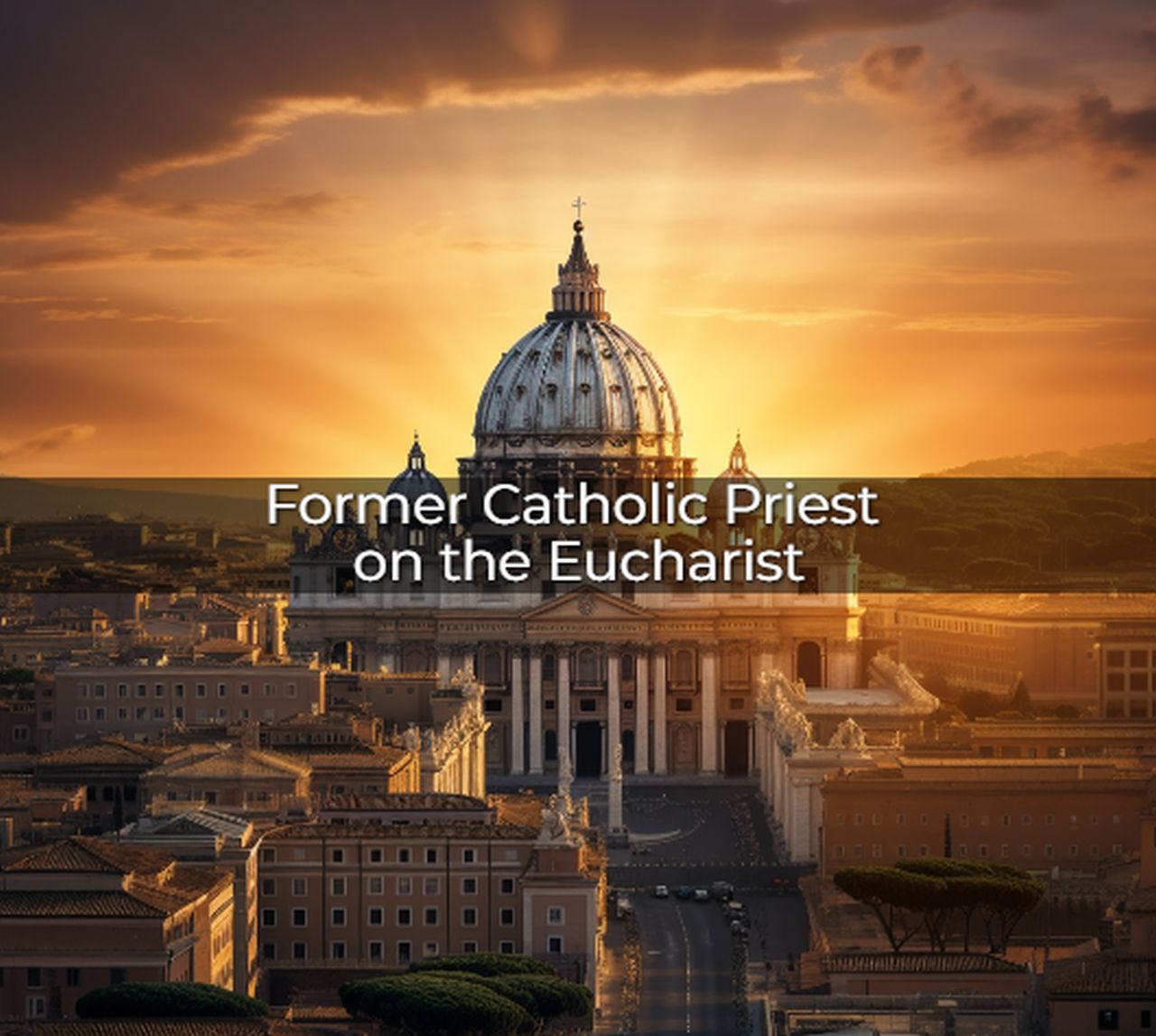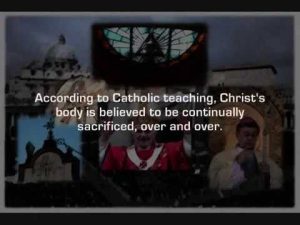Articles
The Mystery of the Eucharist by Former Catholic Priest

Bartholomew f. Brewer, Ph.D.
 Of all the ancient dogmas of the Roman Catholic religion, the dogma of transubstantiation is the most wicked and satanic. It is the very heart of Romanism and the key to the so-called “sacrifice of the mass.” Transubstantiation is Rome’s most lucrative, powerful and fixed dogma. Certainly it is her most effective control device for the perpetuation of her gigantic corporation whose existence is maintained by sacraments administered by a supposedly divinely empowered priesthood.
Of all the ancient dogmas of the Roman Catholic religion, the dogma of transubstantiation is the most wicked and satanic. It is the very heart of Romanism and the key to the so-called “sacrifice of the mass.” Transubstantiation is Rome’s most lucrative, powerful and fixed dogma. Certainly it is her most effective control device for the perpetuation of her gigantic corporation whose existence is maintained by sacraments administered by a supposedly divinely empowered priesthood.
PAGAN ORIGIN
The doctrine of transubstantiation does not date back to the Last Supper as is supposed. It was a controverted topic for many centuries before officially becoming an article of faith, which means that it is essential to salvation according to the Roman Catholic Church. The idea of a corporal presence was vaguely held by some, such as Ambrose, but it was not until 831 A.D. that Paschasius Radbertus, a Benedictine monk, published a treatise openly advocating the doctrine of transubstantiation. Even then, for almost another four hundred years, theological war was waged over this teaching by bishops and people alike until at the Fourth Lateran Council in 1215 A.D., it was officially defined and canonized as a dogma.
 Like many of the beliefs and rites of Romanism, transubstantiation was first practiced by pagan religions. The noted historian Durant said that belief in transubstantiation as practiced by the priests of the Roman Catholic system is “one of the oldest ceremonies of primitive religion.” The Story Of Civilization, p. 741. The syncretism and mysticism of the Middle East were great factors in influencing the West, particularly Italy. Roman Society From Nero To Marcus Aurelius, Dill. In Egypt priests would consecrate mest cakes which were supposed to be come the flesh of Osiris. Encyclopedia Of Religions, Vol. 2, p. 76. The idea of transubstantiation was also characteristic of the religion of Mithra whose sacraments of cakes and Haoma drink closely parallel the Catholic Eucharistic rite. Ibid. The idea of eating the flesh of deity was most popular among the people of Mexico and Central America long before they ever heard of Christ; and when Spanish missionaries first landed in those countries “their surprise was heightened, when they witnessed a religious rite which reminded them of communion…an image made of flour…and after consecration by priests, was distributed among the people who ate it…declaring it was the flesh of deity…” Prescott’s Mexico, Vol. 3.
Like many of the beliefs and rites of Romanism, transubstantiation was first practiced by pagan religions. The noted historian Durant said that belief in transubstantiation as practiced by the priests of the Roman Catholic system is “one of the oldest ceremonies of primitive religion.” The Story Of Civilization, p. 741. The syncretism and mysticism of the Middle East were great factors in influencing the West, particularly Italy. Roman Society From Nero To Marcus Aurelius, Dill. In Egypt priests would consecrate mest cakes which were supposed to be come the flesh of Osiris. Encyclopedia Of Religions, Vol. 2, p. 76. The idea of transubstantiation was also characteristic of the religion of Mithra whose sacraments of cakes and Haoma drink closely parallel the Catholic Eucharistic rite. Ibid. The idea of eating the flesh of deity was most popular among the people of Mexico and Central America long before they ever heard of Christ; and when Spanish missionaries first landed in those countries “their surprise was heightened, when they witnessed a religious rite which reminded them of communion…an image made of flour…and after consecration by priests, was distributed among the people who ate it…declaring it was the flesh of deity…” Prescott’s Mexico, Vol. 3.
The Christian Church for the first three hundred years remained somewhat pure and faithful to the Word of God, but after the pseudo-conversion of Constantine, who for political expedience declared Christianity the state religion, thousands of pagans were admitted to the church by baptism alone with out true conversion. They brought with them pagan rites which they boldly introduced into the church with Christian terminology, thus corrupting the  primitive faith. Even the noted Catholic prelate and theologian, Cardinal Newman, tells us that Constantine introduced many things of pagan origin: “We are told in various ways by Eusebius, that Constantine, in order to recommend the new religion to the heathen, transferred into it the outward ornaments to which they had been accustomed in their own…The use of temples, and these dedicated to particular saints, and ornamented on occasions with branches of trees; incense, lamps, and candles; votive offerings on recovery from illness; holy water; asylums; holydays and seasons, use of calendars, processions, blessings on fields, sacerdotal vestments, the tonsure, the ring in marriage, turning to the East, images at a later date, perhaps the ecclesiastical chant, and the Kyrie Eleison, are all of pagan origin, and sanctified by their adoption into the Church.” An Essay On The Development Of Christian Doctrine, pp. 359, 360. This unholy alliance also allowed the continuance of the pagan custom of eating and drinking the literal flesh and literal blood of their god. This is actually how transubstantiation entered the professing church.
primitive faith. Even the noted Catholic prelate and theologian, Cardinal Newman, tells us that Constantine introduced many things of pagan origin: “We are told in various ways by Eusebius, that Constantine, in order to recommend the new religion to the heathen, transferred into it the outward ornaments to which they had been accustomed in their own…The use of temples, and these dedicated to particular saints, and ornamented on occasions with branches of trees; incense, lamps, and candles; votive offerings on recovery from illness; holy water; asylums; holydays and seasons, use of calendars, processions, blessings on fields, sacerdotal vestments, the tonsure, the ring in marriage, turning to the East, images at a later date, perhaps the ecclesiastical chant, and the Kyrie Eleison, are all of pagan origin, and sanctified by their adoption into the Church.” An Essay On The Development Of Christian Doctrine, pp. 359, 360. This unholy alliance also allowed the continuance of the pagan custom of eating and drinking the literal flesh and literal blood of their god. This is actually how transubstantiation entered the professing church.
Communion God’s Way | Making Peace with God | The Catholic Church Exposed
Support | STORE | Podcasts | Because You Care Page | The Greatest of these is Charity | Be Ready in the Morning [podcast] | The Sure Mercies of David [podcast] | That Repentance and Remission of Sins should be Preached [podcast] | At His Feet | Prepared to be Used of God |
-

 America3 years ago
America3 years agoThe Drugging of America: The Pharmakeia Sorcery Deception [podcast]
-

 Articles3 months ago
Articles3 months agoChildren being Rescued in Tunnels: Happening Now – UPDATE!
-

 Articles6 years ago
Articles6 years agoSelf-Examination in Preparation for the Lord’s Return
-

 Apostasy3 months ago
Apostasy3 months agoSHOCKING List of False Prophets Most Believe are True




































